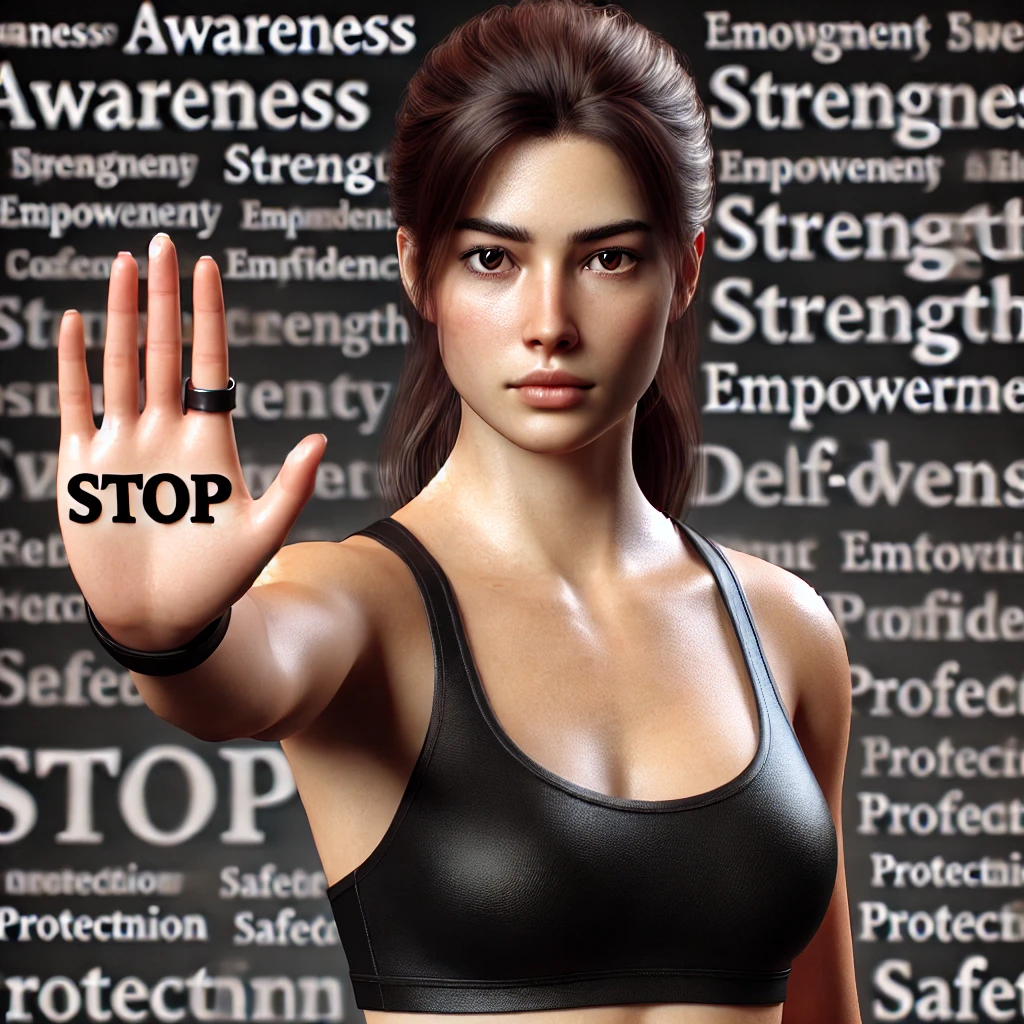When people think of self-defense, they mainly consider physical and “situational” training that provides very minimal knowledge and skills to keep them safe. Undermining or underestimating the amount of work that has to be done to “be safe.” Most people avoid martial arts training due to the discomfort that lies in the training. Most people are unaware of how much the training will change their mindset and resilience and promote self-care, self-respect, and self-sufficiency beyond the mat.
I find it interesting how many women express admiration and are almost shocked when they hear of women who fight back, dare to speak up, and say NO without an apology. They attribute courage and strength to those actions.
I am always shocked to hear that people are surprised by those who dare to stand up for themselves. To me, it takes much more courage to not stand up for yourself. Speaking up and protecting my physical self and the soul inside my body feels too essential to push it to the end of the list of important things to master in life.
The average woman’s perception of self-defense can vary widely and be influenced by personal experiences, cultural background, and level of knowledge or training.
I chose to elaborate on the five most common aspects:
- Physical Techniques: Physical techniques such as striking, blocking, and escaping holds are often taught in self-defense classes. However, under pressure and without context, these techniques can be challenging to perform when facing adversity. It takes time for the nervous system to learn how to adapt to quick changes and handle discomfort.
The process of learning self-defense involves neuroplasticity, where the brain creates and strengthens new neural connections in response to repeated practice and experience. Initially, executing these techniques might feel awkward and difficult because the brain has not yet formed the necessary neural pathways. As training continues, the brain undergoes synaptic pruning, where unnecessary neural connections are eliminated and essential ones are reinforced, making the movements more fluid and automatic (Kandel, 2000).
Moreover, the nervous system plays a crucial role in managing the body’s response to stress. The fight-or-flight response, mediated by the autonomic nervous system, can impair cognitive and motor functions, making it difficult to perform complex physical actions under stress. Through repeated exposure to simulated high-pressure situations in self-defense training, individuals can condition their nervous systems to remain calm and maintain control, thereby improving their ability to execute techniques effectively (Sapolsky, 2004).
- Situational Awareness: situational awareness includes not only external threats but also an understanding of how your body language communicates your emotional state. Being aware of one’s surroundings and potential threats, as well as recognizing and avoiding dangerous situations, is crucial for personal safety. However, our presence in a given space is also a significant part of the “situation” and should be included in our awareness. Body language is a powerful, often subconscious form of communication that others can sense and interpret.
Your body language is deeply influenced by your emotions and self-esteem. The brain’s limbic system, which governs emotional responses, plays a key role in how we project our feelings through body language (LeDoux, 2000). When you feel confident and empowered, your body language tends to be more open and assertive. Conversely, feelings of fear or insecurity can manifest as closed, defensive postures.
- Verbal Strategies: Using assertive communication to de-escalate potential conflicts or to call for help is an essential skill. However, relying solely on verbal assertiveness without the ability to back it up physically is not a complete strategy. The effectiveness of your voice is significantly enhanced when it is supported by confident body language and the capability to defend yourself if necessary.
Your voice will be louder and more impactful if you truly mean what you say. De-escalate without the ability to fight back can be preserved as an empty threat. The congruence between your verbal and non-verbal communication is crucial. Neuroscientific studies show that when verbal messages are inconsistent with body language, people are more likely to believe the non-verbal cues. A recent study by Vrij et al. (2019) found that non-verbal cues play a critical role in communication, especially in situations involving stress or conflict. This means that assertive words must be matched with assertive body language to be perceived as credible and strong.
- “Personal Safety” Devices: While carrying self-defense tools can offer some level of protection, relying solely on them can be dangerous. They should be part of a broader personal safety strategy. Proper training and preparedness are crucial for effective self-defense and can significantly improve your ability to protect yourself in a real-life confrontation.
Relying solely on “self-defense devices” such as whistles, pepper spray, personal alarms, or even keys held in a defensive manner is WRONG! In the past, I wrote an article about the wrong perception that those tools will keep one safe. Please read the blog about pepper spray for personal safety.
- Confidence and Empowerment: Confidence and empowerment are not transient feelings that come and go after 2-3 classes; they are the promised results of consistent training. Research shows that the brain’s neuroplasticity allows for long-term changes in confidence and self-efficacy with regular practice. The more you train, the more you reinforce the neural pathways associated with these positive traits, leading to sustained improvements (Draganski et al., 2004).
Additionally, the harder you work during each session, the more significant the neurochemical responses, such as the release of endorphins and dopamine, which enhance mood and reinforce the behavior (Schultz, 2015). Consistent effort in training not only builds physical skills but also strengthens mental resilience and self-belief.
Why do Women perceive it as a difficult thing to accomplish?
Many cultures do not prioritize or encourage women to learn self-defense, seeing it as unnecessary or unfeminine. While women are more prone to suffer sexual violence than men, it is shocking that our society doesn’t advocate for self-defense as part of formal education. As a father, I couldn’t allow my children to be subjected to violence without providing them with the proper education to handle it.
Due to the narrative that “women can’t fight men,” many women feel physically incapable or psychologically unprepared to engage in self-defense training. Giving up before trying is a defeat in itself. I believe that if more people were educated about the effects of self-defense on the body and mind, they would not underestimate its effectiveness or doubt that self-defense techniques would be useful in a real-life situation against a stronger or more aggressive attacker.
Undermining the preventative aspect of training is also a significant factor in not engaging in training in the first place. Much like a trained body, a ‘trained’ mind is more likely to deal with different situations – either stressful or alarming – more efficiently. More times than I can count, I have heard people say, “I already took a few classes when I was in 4th grade or college, or my father taught me some tricks when I was a teenager.” Or worse, “I learned many different techniques from YouTube!” They fail to consider the power of empowerment.
The basic principles are to first learn how to identify problems and try to prevent, avoid, or de-escalate the confrontation. If you can’t, then the second principle is you need to win.
Perceived safety is another reason women avoid self-defense training. They believe that they live in a safe environment or are unlikely to encounter situations where self-defense would be necessary. Under “normal” circumstances, they are correct until circumstances change and they are no longer right. It’s like putting all your money in the stock market and assuming the market will never crash. Sadly, you only need to be wrong once for this approach to fail.
The idea of confronting potential violence can be distressing, and some women might avoid self-defense training because it forces them to think about uncomfortable scenarios. Violence is a life-changing event that has long-lasting and profound effects on those who experience it. Even if we are lucky enough not to experience it, we are still affected by it. Many of our daily decisions are made through the “personal safety” filter and how much we fear violence and altercations altogether.
While it is extremely important that we build a routine that feels safe for us, feeling safe and being safe are not the same. Ignorance isn’t always bliss. We only need to acknowledge the statistics—1 in 4 American women reports experiencing at least one sexual assault incident in her lifetime. Among college students, about 13% experience rape or sexual assault through physical force, violence, or incapacitation, with the rate rising to approximately 26% for undergraduate women. Reported numbers aren’t the full truth; those are only the cases where victims have stepped forward. I hate to imagine how many didn’t report it.
Adopting strength into your lifestyle shouldn’t be for the “brave,” it must be a standard.
Self-defense means much more than just physical techniques. But let’s face it; if you have been on the mat for a few consistent weeks, you are already hooked, and it is harder to explain to someone who hasn’t tried it yet. It’s a lifestyle of bruises as a vague of honor, breaking myths, and shattering glass ceilings—not relying on others to save you.
Let your inner strength guide you, and allow your true self to break free!
Do something amazing,
Tsahi Shemesh
Founder & CEO
Krav Maga Experts
References
- Kandel, E. R. (2000). Principles of Neural Science. McGraw-Hill.
- Sapolsky, R. M. (2004). Why Zebras Don’t Get Ulcers: The Acclaimed Guide to Stress, Stress-Related Diseases, and Coping. Holt Paperbacks.
- Shumway-Cook, A., & Woollacott, M. H. (2016). Motor Control: Translating Research into Clinical Practice. Lippincott Williams & Wilkins.
- LeDoux, J. E. (2000). Emotion circuits in the brain. Annual Review of Neuroscience, 23(1), 155-184.
- Vrij, A., Leal, S., Mann, S., Vernham, Z., & Brankaert, F. (2019). Reading lies: Nonverbal communication and deception. Annual Review of Psychology, 70, 295-317.
- Draganski, B., Gaser, C., Busch, V., Schuierer, G., Bogdahn, U., & May, A. (2004). Changes in grey matter induced by training. Nature, 427(6972), 311-312.
- Schultz, W. (2015). Neuronal Reward and Decision Signals: From Theories to Data. Physiological Reviews, 95(3), 853-951.
- Draganski, B., Gaser, C., Busch, V., Schuierer, G., Bogdahn, U., & May, A. (2004). Changes in grey matter induced by training. Nature, 427(6972), 311-312.
- Schultz, W. (2015). Neuronal Reward and Decision Signals: From Theories to Data. Physiological Reviews, 95(3), 853-951.


















